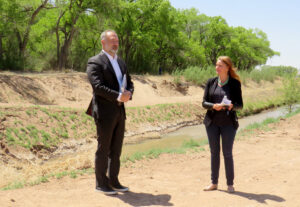Biden restores protection for national monuments Trump shrank: 5 essential reads

On Oct. 7, 2021, the Interior Department announced that President Biden was restoring protection for three U.S. national monuments that the Trump administration sought to shrink drastically: Bears Ears and Grand Staircase-Escalante in Utah, and Northeast Canyons and Seamounts in the Atlantic Ocean. President Trump’s 2017 orders downsizing these monuments, originally created by previous administrations, ignited debate over whether such action was legal. Here are five articles from our archives that examine this controversy.
1. A law rooted in presidential power
Presidents can designate lands as national monuments quickly, without seeking consent from Congress, under the 1906 Antiquities Act. Congress passed the law to protect historically valuable archaeological sites in the Southwest that were being looted.
But as the late John Freemuth, a public policy scholar at Boise State University, observed, presidents soon were using it much more expansively – and affected interests pushed back:
Freemuth predicted in a 2016 article that “future designations will succeed only if federal agencies consult widely in advance with local communities and politicians to confirm that support exists.”
2. Can presidents alter monuments their predecessors created?
Many environmental advocacy groups and tribes opposed President Trump’s order to remove large swaths of land from these three monuments and sued to block it. The Antiquities Act is silent on this question. But when The Conversation asked environmental lawyers Nicholas Bryner, Eric Biber, Mark Squillace and Sean Hecht, they argued – based on other environmental statutes and legal opinions – that such acts would require congressional approval:
3. Monuments have scenic, cultural and scientific value
National monuments protect many unique resources. For example, Bears Ears conserves land where Indigenous people have lived, hunted and worshiped for centuries. The Bears Ears designation was requested by an intertribal coalition and approved by President Barack Obama after extensive consultation with tribal governments.
Many national monuments contain scenic lands and areas that are critical habitat for endangered species, such as desert tortoises and California condors. The underwater canyons of Northeast Canyons and Seamounts house sponges, corals, squid, octopus, numerous fish species and endangered sperm whales.
Monuments also can have important scientific value. President Bill Clinton designated Grand Staircase-Escalante partly to protect thousands of unique fossil sites, most of which had yet to be studied. Many were located in areas near potential shale gas, coal or uranium extraction zones.
“Decades of ongoing research in this region have literally rewritten what scientists know about Mesozoic life, especially about the ecosystems that immediately preceded the final extinction of the dinosaurs,” Indiana University earth scientist P. David Polly writes. “Paleontologists like me know that the still-pristine Grand Staircase-Escalante region has divulged only a fragment of its paleontological story.”
4. How a Native American Interior Secretary sees it
The stark difference between the Trump and Biden administrations’ public land policies can be summed up by comparing their respective interior secretaries.
President Trump chose U.S. Rep. Ryan Zinke of Montana to head the agency, which manages more than 480 million acres of public lands, including national monuments. Zinke, who supported opening public lands for oil and gas development and mining, led a review that proposed shrinking the three monuments Biden has just restored.
President Biden’s interior secretary, former U.S. Rep. Deb Haaland of New Mexico, is the first Native American to head the agency that maintains government-to-government relationships with and provides services to Native American Indian tribes and Alaska Native entities.
“For Native Americans, seeing people who look like us and are from where we come from in some of the highest elected and appointed offices in the U.S. demonstrates inclusion. Indian Country finally has a seat at the table,” writes Arizona State University Indigenous studies scholar Traci Morris.
5. Monuments aren’t always beloved at first
Some of the most popular U.S. national parks initially were protected as national monuments, then expanded and given national park status by Congress years later. They include Acadia in Maine, Joshua Tree in Southern California, and Arches in Utah.
But a site’s merit may not be obvious at first. As Arizona State University’s Stephen Pyne writes, the first Europeans who explored the Grand Canyon in the 18th and 19th centuries thought it was unremarkable or worse; one called it “altogether valueless.”
Then geologists working for the federal government traversed the canyon, and wrote rapturous accounts that recast it as a marvel – a shift that Pyne calls “an astonishing reversal of perception”:
President Theodore Roosevelt agreed. After making multiple visits to the canyon, he designated it as a national monument in 1908.
This article was originally posted on Biden restores protection for national monuments Trump shrank: 5 essential reads







